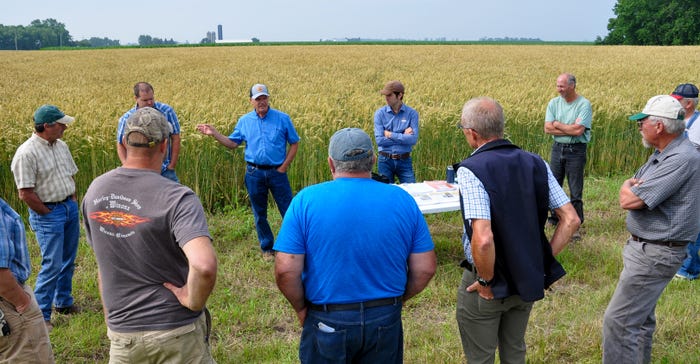July 25, 2019

RYE INTEREST: About 40 local farmers gathered July 9, two weeks before harvest, to hear Rick and Tim Neuvirth relate their experience with hybrid rye, a crop that’s new to the Midwest that they feed to their hogs.Lynn Betts
The cereal rye Rick Neuvirth and his sons are growing is not the rye you’ve likely heard about or might be using for cover crops.
It’s a cross-bred hybrid rye — like hybrid corn, it contains the best traits of parent varieties. And like hybrid corn, it significantly out-performs inbred cereal rye varieties, with predicted yields of 100 bushels an acre and higher.
Rick and his sons Tim and Brian are growing 115 acres of hybrid rye this year, using it as a transition crop to a more complete organic operation. They replaced 10% of the corn in their swine ration with hybrid rye and barley last year, and this year will replace 10% of the corn with hybrid rye.
“We’ve always fed oats as part of our ration in the past, but after we went to Tom Franzen’s farm to see hybrid rye two years ago, we’ve thought hybrid rye could be better than oats,” Tim said. “We like nutrient-dense grain that keeps our sows satisfied after feeding, and the digestible fiber in hybrid rye is a big thing. We believe it’s going to keep our sows and pigs healthy, without drugs.”
The Neuvirths farm 1,900 acres together, with a home base in Elkton in south-central Minnesota. Their hybrid rye fields lie just south of Rose Creek, where they hosted a field day July 9 with Albert Lea Seed and KWS Seeds, about two weeks ahead of this year’s expected harvest. There is producer interest in hybrid rye — this field day attracted about 40 farmers, and three others in southern Minnesota and northern Iowa drew from 60 to more than 100 farmers each.
Most of the Neuvirth’s crop acres are either in organic production or transitioning to organic. About 400 acres of their corn is non-GMO, which they use in their sow ration. Together, they have 850 sows, selling feeder pigs — Berkshire boars and cross-bred females — for a niche market. They also have a few Dexter beef cows.
“We replaced 10% of our corn with a 50-50 barley and hybrid rye mix last year,” Tim said. “We hadn’t planned to feed barley, but we planted the rye so late — in October after soybean harvest — that the result was we had only a half stand of hybrid rye in the spring of 2018. So, we drilled barley into the same field — barley and rye mature about the same time — harvested them and put that rye-barley mixture into our ration with corn. The hogs liked it, but we didn’t do any performance comparisons because our intent is to feed hybrid rye with corn.”
This year, after harvest, the Neuvirths will include rye in the diet for a number of gestating and lactating sows, as well as baby pigs for about 8 weeks in the nursery. They will then compare the performance of sows and pigs that had hybrid rye in the diet against those with corn. “We were thinking about selling the rye, and we might still sell some,” Rick said. “You could probably sell it for $6 a bushel, and that’s tempting. But we want to see how our pigs do with it, so we’re going to feed most of it.”
Rick said hybrid rye is a really good tool for farmers to use to transition to organic.
“We’re always looking for small grain crops that build the soil, fit into a rotation and offer weed control in an organic operation,” Tim said. “Hybrid rye typically doesn’t need any herbicides for weed control and it will yield more than twice as much as oats with a high energy density.”
“The hybrid rye isn’t weed-free but it’s clean enough,” Rick added. Another thing Rick likes about rye is standability.
“We had 50 mile an hour winds and heavy rain eight days ago,” Rick told farmers at the field day. “There were a few pockets where the rye went down, but it’s really strong compared to oats.”
With the rye fields 12 miles from Neuvirth’s home base, they decided to buy liquid hog manure. They had it broadcast and incorporated last fall before drilling hybrid rye at 600,000 seeds per acre. The manure provided around 120 pounds of total nitrogen per acre for the rye.
“We figured our biggest cost was $85 an acre for hog manure,” Rick said. “The seed was about $50 an acre.”
Betts is a freelancer from Johnston, Iowa.
Hybrid rye new to U.S.
KWS Seeds came out with hybrid rye in Germany in 1986 and took 15 years to produce enough seed for commercial use in Europe.
Its use is growing quickly across Europe. In the U.S. and Canada, KWS is the only company distributing hybrid rye seed through local suppliers.
Claus Nymand, KWS’ hybrid rye product manager for the U.S. and Canada, offered more growing tips for farmers at the field day:
The month of September is optimum time to plant
Drill seed for more precise populations
Use 1.1 to 1.2 lbs. total N for each expected bushel of yield
Apply up to half the N in fall, along with P and K per soil test
Apply sulfur in spring
Harvest when grain moisture is below 17%
It’s not a good idea to use 2,4-D and MCPA with hybrid rye
Don’t use a fungicide
About the Author(s)
You May Also Like




